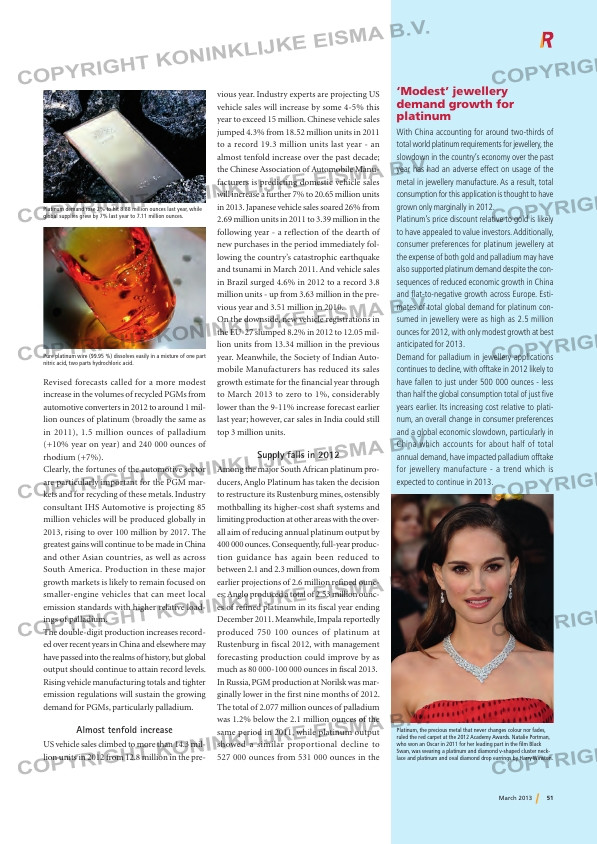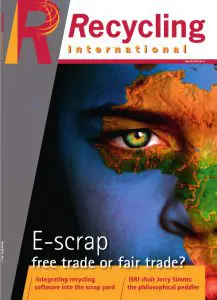Page 51 from: March 2013

51March 2013
vious year. Industry experts are projecting US
vehicle sales will increase by some 4-5% this
year to exceed 15 million. Chinese vehicle sales
jumped 4.3% from 18.52 million units in 2011
to a record 19.3 million units last year – an
almost tenfold increase over the past decade;
the Chinese Association of Automobile Manu-
facturers is predicting domestic vehicle sales
will increase a further 7% to 20.65 million units
in 2013. Japanese vehicle sales soared 26% from
2.69 million units in 2011 to 3.39 million in the
following year – a reflection of the dearth of
new purchases in the period immediately fol-
lowing the country’s catastrophic earthquake
and tsunami in March 2011. And vehicle sales
in Brazil surged 4.6% in 2012 to a record 3.8
million units – up from 3.63 million in the pre-
vious year and 3.51 million in 2010.
On the downside, new vehicle registrations in
the EU-27 slumped 8.2% in 2012 to 12.05 mil-
lion units from 13.34 million in the previous
year. Meanwhile, the Society of Indian Auto-
mobile Manufacturers has reduced its sales
growth estimate for the financial year through
to March 2013 to zero to 1%, considerably
lower than the 9-11% increase forecast earlier
last year; however, car sales in India could still
top 3 million units.
Supply falls in 2012
Among the major South African platinum pro-
ducers, Anglo Platinum has taken the decision
to restructure its Rustenburg mines, ostensibly
mothballing its higher-cost shaft systems and
limiting production at other areas with the over-
all aim of reducing annual platinum output by
400 000 ounces. Consequently, full-year produc-
tion guidance has again been reduced to
between 2.1 and 2.3 million ounces, down from
earlier projections of 2.6 million refined ounc-
es; Anglo produced a total of 2.53 million ounc-
es of refined platinum in its fiscal year ending
December 2011. Meanwhile, Impala reportedly
produced 750 100 ounces of platinum at
Rustenburg in fiscal 2012, with management
forecasting production could improve by as
much as 80 000-100 000 ounces in fiscal 2013.
In Russia, PGM production at Norilsk was mar-
ginally lower in the first nine months of 2012.
The total of 2.077 million ounces of palladium
was 1.2% below the 2.1 million ounces of the
same period in 2011, while platinum output
showed a similar proportional decline to
527 000 ounces from 531 000 ounces in the
‘Modest’ jewellery
demand growth for
platinum
With China accounting for around two-thirds of
total world platinum requirements for jewellery, the
slowdown in the country’s economy over the past
year has had an adverse effect on usage of the
metal in jewellery manufacture. As a result, total
consumption for this application is thought to have
grown only marginally in 2012.
Platinum’s price discount relative to gold is likely
to have appealed to value investors. Additionally,
consumer preferences for platinum jewellery at
the expense of both gold and palladium may have
also supported platinum demand despite the con-
sequences of reduced economic growth in China
and flat-to-negative growth across Europe. Esti-
mates of total global demand for platinum con-
sumed in jewellery were as high as 2.5 million
ounces for 2012, with only modest growth at best
anticipated for 2013.
Demand for palladium in jewellery applications
continues to decline, with offtake in 2012 likely to
have fallen to just under 500 000 ounces – less
than half the global consumption total of just five
years earlier. Its increasing cost relative to plati-
num, an overall change in consumer preferences
and a global economic slowdown, particularly in
China which accounts for about half of total
annual demand, have impacted palladium offtake
for jewellery manufacture – a trend which is
expected to continue in 2013.
Platinum, the precious metal that never changes colour nor fades,
ruled the red carpet at the 2012 Academy Awards. Natalie Portman,
who won an Oscar in 2011 for her leading part in the film Black
Swan, was wearing a platinum and diamond v-shaped cluster neck-
lace and platinum and oval diamond drop earrings by Harry Winston.
Revised forecasts called for a more modest
increase in the volumes of recycled PGMs from
automotive converters in 2012 to around 1 mil-
lion ounces of platinum (broadly the same as
in 2011), 1.5 million ounces of palladium
(+10% year on year) and 240 000 ounces of
rhodium (+7%).
Clearly, the fortunes of the automotive sector
are particularly important for the PGM mar-
kets and for recycling of these metals. Industry
consultant IHS Automotive is projecting 85
million vehicles will be produced globally in
2013, rising to over 100 million by 2017. The
greatest gains will continue to be made in China
and other Asian countries, as well as across
South America. Production in these major
growth markets is likely to remain focused on
smaller-engine vehicles that can meet local
emission standards with higher relative load-
ings of palladium.
The double-digit production increases record-
ed over recent years in China and elsewhere may
have passed into the realms of history, but global
output should continue to attain record levels.
Rising vehicle manufacturing totals and tighter
emission regulations will sustain the growing
demand for PGMs, particularly palladium.
Almost tenfold increase
US vehicle sales climbed to more than 14.3 mil-
lion units in 2012 from 12.8 million in the pre-
Platinum demand rose 2% to hit 8.88 million ounces last year, while
global supplies grew by 7% last year to 7.11 million ounces.
Pure platinum wire (99.95 %) dissolves easily in a mixture of one part
nitric acid, two parts hydrochloric acid.
RI_2-PGM.indd 51 06-03-13 09:20



